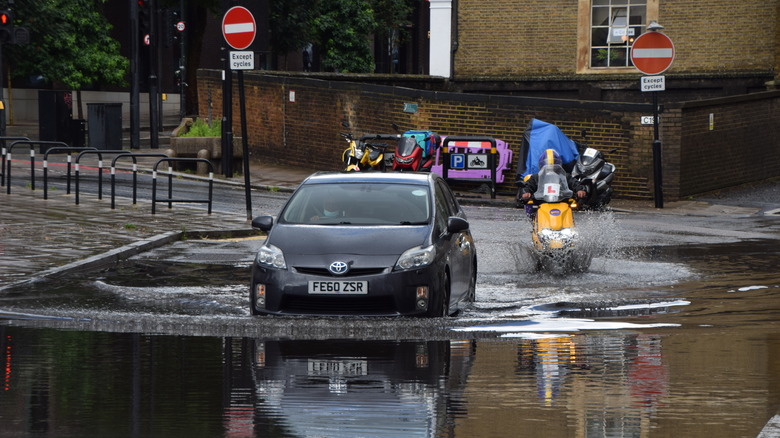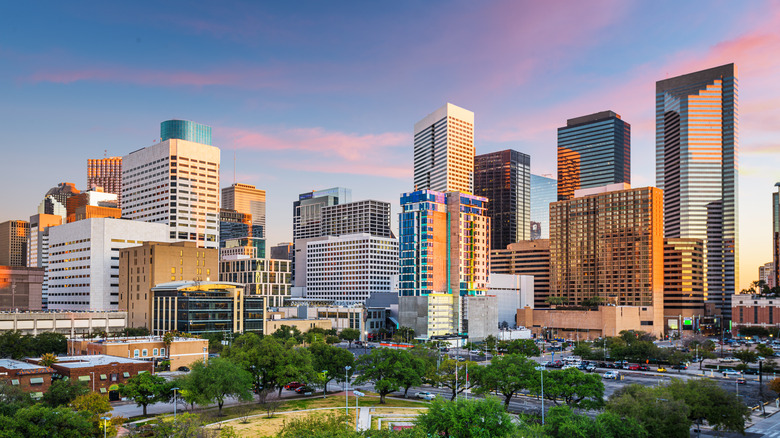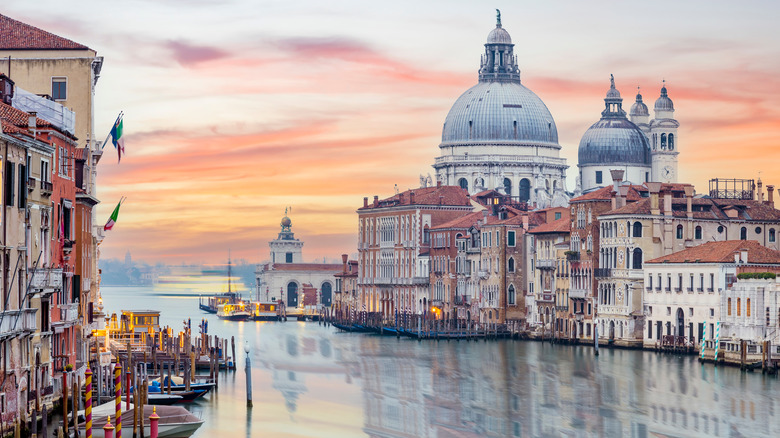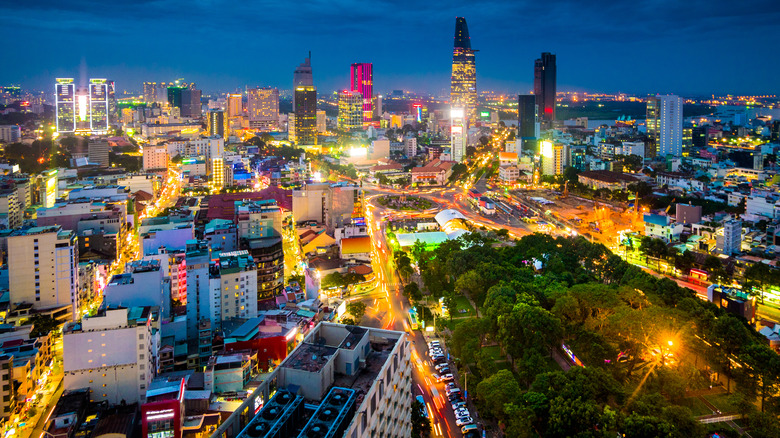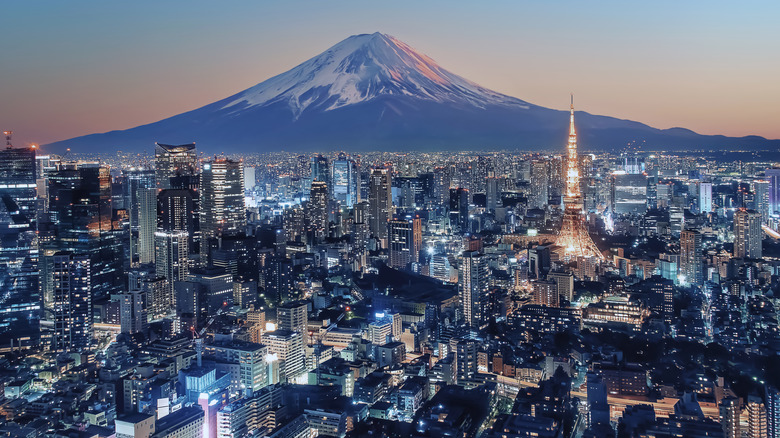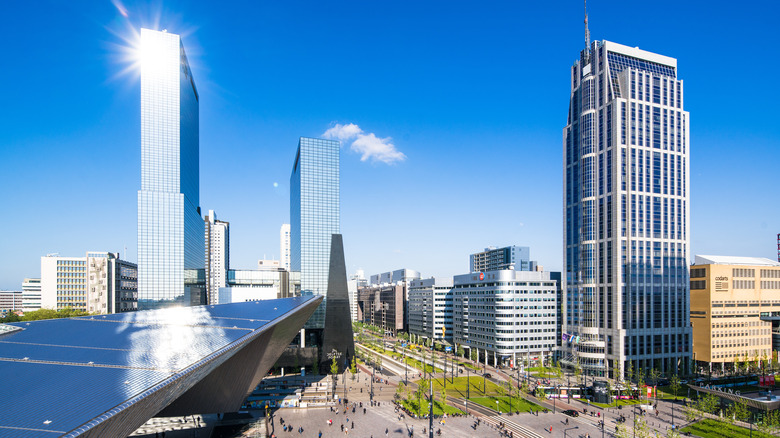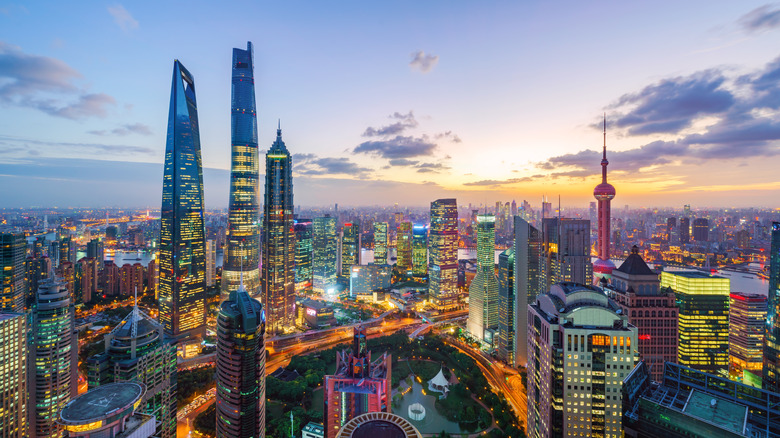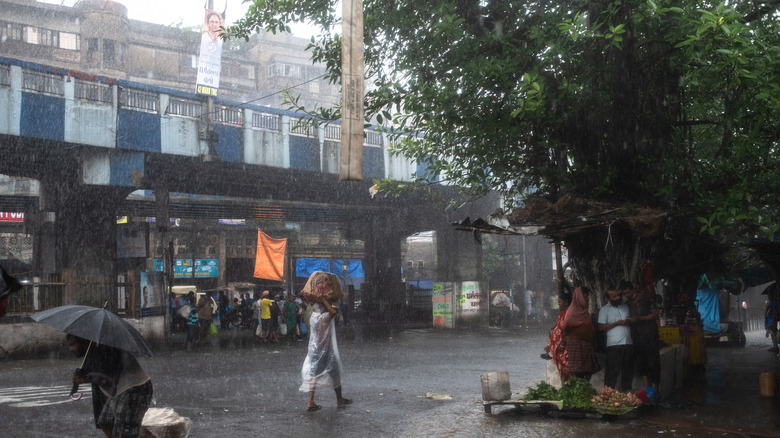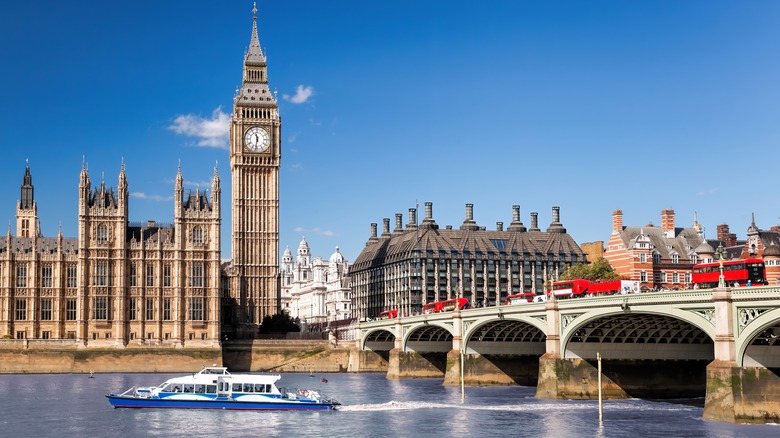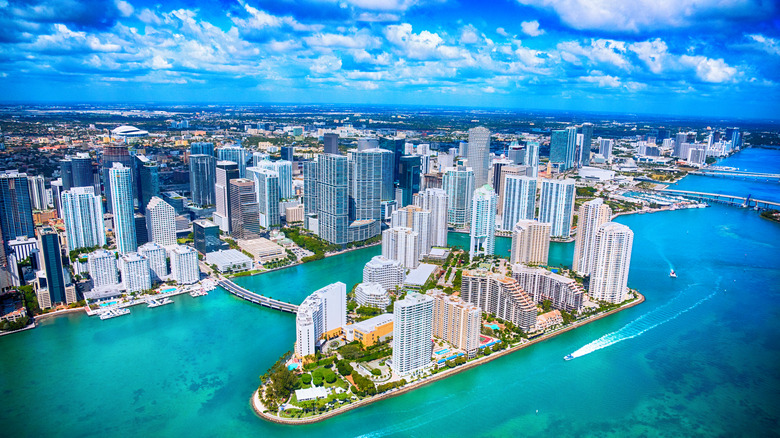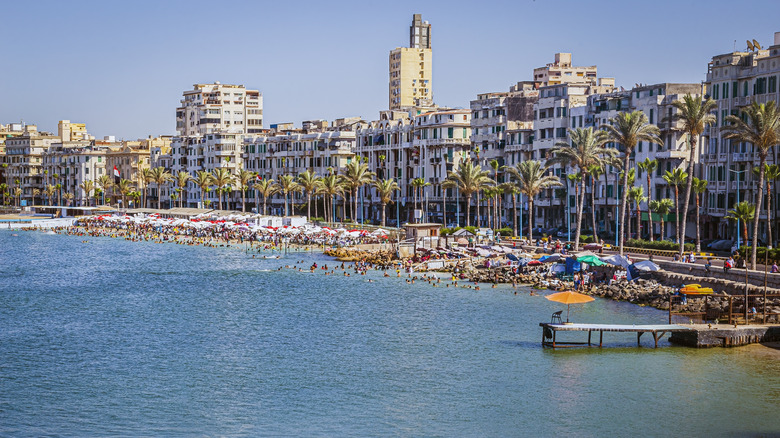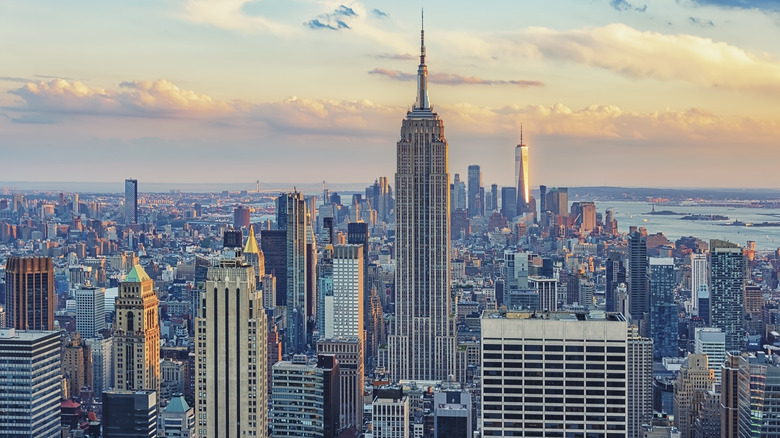Cities Around The World That Are Sinking
Human beings have always co-existed a little uneasily with nature, and perhaps no more so than in the modern age. The industrialization of the last century or so has brought with it a host of issues, none more pressing than global climate change. Unfettered burning of fossil fuels and the accompanying carbon dioxide emissions have resulted in a so-called "Greenhouse Effect" that slowly but surely warms the planet, causing ice caps to melt and sea levels to rise. Those rising sea levels are a serious problem in coastal regions, and the increasingly severe weather events caused by climate change are no joke, either — but since there's a ton of money to be made in fossil fuels, certain parties are a touch resistant to altering the status quo. Despite scientists telling anyone who will listen that green energy could literally save the planet, CO2 emissions reached their highest level ever in 2021.
About those coastal regions — when combined with the wanton extraction of groundwater, which over time causes the ground to settle (an effect referred to as ground subsidence), increased flooding brought on by climate change can contribute to a bit of a sinking feeling among residents of those regions. That is to say, there are many large urban population centers around the world that are literally sinking — and if drastic measures are not taken over the next few decades to alleviate the problem, some of them could disappear altogether under the ocean.
Houston, Texas
Situated on Galveston Bay off the Gulf of Mexico, Houston, Texas is home to 2.3 million people, making it the fourth-largest city in the United States. In 2022, a study titled "Subsidence in Coastal Cities Throughout the World Observed by InSAR" (that's Interferometric Synthetic Aperture Radar) took a look at the extent to which groundwater extraction is causing 99 cities around the world to ease downwards at rates relative to the rising of sea levels. The study spelled out bad news for Houston: Among 33 cities that are sinking at a rate in excess of one centimeter per year, Houston is sinking the 10th-fastest. At a rate of 1.95 centimeters annually, Houston is the only city in the entire Western Hemisphere to crack the top (or bottom, if you will) ten.
According to the Houston Chronicle, measures have been taken to slow the sinking, including reduced groundwater pumping — but subsidence can only be slowed, not reversed, and there are no easy solutions for the city. With respect to the rising sea levels which are greatly compounding the problem, the U.S. Army Corps of Engineers has proposed a "Multiple Lines of Defense" strategy employing sea barriers, flood gates, and pumping stations to mitigate surges in the Gulf — but if such strategies are not deployed quickly, or prove to be ineffective, the study suggests that Houston as we know it could literally vanish by 2100.
Venice, Italy
The city of Venice, Italy has famously been half-underwater for the entirety of its existence; that's part of its charm, as it's a lot tougher to row gondolas through dusty ditches than scenic canals. One would think that it would be more prepared than most areas to handle rising levels of water — but at the time of the city's founding roughly 16 centuries ago, those levels were about six feet lower than they are today, and there is only so much that can be done to accommodate such drastic change.
The 2022 study examining subsidence in coastal cities concluded that Venice is taking a long bath, and not the pleasant, relaxing kind. It is sinking at a rate of 1 to 2 millimeters per year, and the islands in its famed lagoon — over a hundred of them — are subsiding even faster. The city is also among those in danger of disappearing altogether, but Venice is not without a plan. Begun in 1992, Mose — a system of mobile barriers designed to protect the city from sea surges — is scheduled to finally be completed in late 2023. This, however, does nothing to combat the complicated issue of ground subsidence in Venice — and some, like nonprofit We Are Here Venice executive director Jane da Mosto, have deemed it "a highly impacting, heavily engineered and ... overly complicated solution" (via BBC).
Bangkok, Thailand
In 2021, the nonprofit think tank Germanwatch released its Global Climate Risk Index, which examines the extent to which countries around the globe are affected by extreme weather events and other hardships brought on by climate change. The study articulated a grim warning for Thailand and its capital of Bangkok, one of the world's largest population centers with a population of roughly 10 million people. The country ranked ninth on the list of areas affected most by climate change — and as noted by the Bangkok Post, this represented a whopping 34-spot jump from the 2011 edition of the index, in which Thailand ranked 43rd.
Thanawat Jarupongsakul, president of the climate think tank Thailand Global Warming Academy, spelled the situation out for that publication in no uncertain terms. "If nothing is done to protect Bangkok's shoreline, the waterline will slowly creep further inland by about 1.3 kilometers every year," he said. "It is likely that most of Bangkok Metropolitan will sink beneath sea level within the next 100 years." Government officials have floated (no pun intended) the notion of a barrier system, along with coastal dykes, to help mitigate rising sea levels — but as Jarupongsakul points out, what works for other regions may not necessarily work for Bangkok, and he stressed the need to take a more region-specific approach than the government is currently considering.
Ho Chi Minh City, Vietnam
In 2022, a study was published in the journal Nature succinctly titled "Sinking Cities, Rising Seas." The study concluded that the highest concentration of countries with out-of-control land subsidence rates was in Southeast Asia, with the highest rates of subsidence to be found in that region exceeding an eye-watering 16 millimeters per year. This is extremely bad news for very large, still-expanding cities such as Ho Chi Minh City — the Vietnamese capital, home to over 9 million people, which in recent years has been experiencing flooding like never before in its history.
As reported by Channel News Asia, government projects to raise roads and structures have been undertaken to combat the encroaching waters — but this Band-Aid approach offers nothing in the way of long-term solutions, and with the city's population (and therefore, new construction) continuing to proliferate, the Ho Chi Minh could be headed for disaster unless more pragmatic strategies are employed. Nguyen Viet Ky, who leads the Geotechnics Division at Ho Chi Minh City University of Technology, singles out all the new development as being particularly problematic, saying, "It's clear that there's too much development density concentrated in weak foundation areas." If it continues on its current course, the aforementioned study suggests that Ho Chi Minh City, too, could soon face an existential threat from the rising waters.
Tokyo, Japan
One would think that, if your extremely populous capital city were situated on a big island, the practice of extracting groundwater may not exactly be necessary — but this is not the case. Tokyo pumped water out of its plains for decades, and as noted by a study titled "Land Subsidence and Groundwater Management in Tokyo" published by the International Review for Environmental Strategies, the practice was partially responsible for the city sinking to a jaw-dropping 58 meters below sea level by the '60s. Extraction has been halted, and Tokyo has sought to keep the problem of rising flood waters in check with a vast underground system of cisterns, completed in 2006, that divert excess water away from areas prone to flooding — but in the face of increased rainfall caused by climate change, this may no longer be adequate.
As reported by The New York Times, rainfall exceeding two inches per hour in Tokyo has increased by 30% in the last 30 years, resulting in more and worse flooding — and as an area is also prone to earthquakes and typhoons, many residents of the city would probably rather contend with periodic visits from Godzilla than face the ramifications of its real-world issues. As civil engineer and anti-flood expert Nobuyuki Tsuchiya told The Times, "Tokyo faces dangers on all sides. It's difficult to say that it's doing enough."
Rotterdam, The Netherlands
The Netherlands faces a land subsidence issue that is worse than most. Its famous windmills are not just for tourists to take selfies in front of; for hundreds of years, they've been used to pump water out of the ground for use in farming, and some areas of the country are sinking at the ridiculous rate of 8 millimeters annually. The Dutch, though, take a radically different approach to keeping themselves dry. Rather than trying to hold back the waters or raise structures above it, they seek to live with it — by giving the inevitable floods friendly places to go, where they will cause the least damage and hardship.
Speaking with The New York Times, water management expert Henk Ovink described how more traditional approaches don't make sense for cities like the slowly sinking Rotterdam, of which 90% is below sea level. "We can't just keep building higher levees ... We need to give the rivers more places to flow," he said. This includes making use of public spaces, like parks and plazas, to double as overflow areas in the event of flooding. The approach seems to be working — a recent study titled "City-To-City Learning for Urban Resilience: The Case of Water Squares in Rotterdam and Mexico City" concluded that the use of overflow areas has greatly contributed to Rotterdam having one of the more effective flood management strategies worldwide, one worthy of emulation.
Shanghai, China
In a 2021 research paper titled "Risk Assessment of Shanghai Extreme Flooding Under the Land Use Change Scenario," climate scientists Xinmeng Shan, Jie Yin, and Jun Wang used a multidisciplinary modeling approach to peek into the future of Shanghai, a mega-metropolis of over 29 million people. What they saw was catastrophic damage due to flooding, rising near-exponentially and costing more and more millions of yuan every year, with the most affected areas including the sprawling city center — but this was far from an unexpected forecast for a city that has suffered some of the worst land subsidence of any city, anywhere.
As pointed out by Yin and colleague Dapeng Yu in a 2023 article for 360 Info, Shanghai's average annual rate of subsidence sat at an astonishing 23 millimeters for over eight decades, between 1921 and 2007. Rising sea levels due to climate change are only part of the city's problem. As Shanghai's flood control infrastructure ages, the risk of dike and seawall failure rises right along with those water levels, increasing the chances of devastating flooding events — particularly in areas like the Huangpu River floodplain, which includes the city center. Yin and Yu offered specific recommendations to avert disaster, including a mobile barrier system, upgrading the current array of seawalls, and the construction of underground water storage facilities like those in Tokyo — but it remains to be seen if any of these measures will be adopted.
Kolkata, India
With a population of over 15 million, Kolkata, India (formerly Calcutta) is another region in which a whole lot of people are threatened with displacement due to extreme flooding. Even worse, the risk to the region may have actually been underestimated in recent years, as spelled out in a study conducted by scientists at the National Center for Atmospheric Research in Boulder, Colorado, titled "Increased Exposure of Coastal Cities to Sea Level Rise Due to Internal Climate Variability." Those last three words are key: The paper suggests that current models forecasting rising sea levels fail to take into account natural fluctuations in climate, which could spell... well, an even greater disaster for low-lying areas like Kolkata.
In an interview with India Times, the study's co-author Aixie Hu sounded the alarm, saying, "In a worst-case scenario, the combined effect of climate change and internal climate variability could result in local sea levels rising by more than 50% of what is due to climate change alone." That is, obviously, incredibly significant. Compounding the issue, Kolkata's sewer network is roughly a century old and only covers about half of the city's total area. These factors, combined with an estimated subsidence rate of around 13 millimeters annually and continued development eating away at Kolkata's natural flood defenses, could spell catastrophe for the city in the near future — and currently, very little is being done to address the issue.
London, England
The River Thames has, of course, played an important historical role in the city of London — but these days, residents of the city tend to eye the raging river with a bit of trepidation. Despite the fact that a massive flood defense system was installed across the river over four decades ago, the Thames has swelled to scary levels in recent years. As University of Southampton professor Ivan Haigh pointed out to CNN, "Even if we reduce our emissions to negative now, we will see at least a meter of sea level rise" — and since it's safe to say that that won't be happening, the Thames is likely to swell to truly threatening levels in the decades to come.
Due to increased rainfall, London already pumps and disperses over 70 million liters of water daily to prevent constant flooding — and as a city essentially built on clay, it also has a unique subsidence problem. According to the British Geological Survey, climate change is likely to induce in the region frequent deluges followed by periods of drought, which will cause the ground beneath London's foundations to shrink, swell — and, eventually, crack. This phenomenon is already taking effect to a limited degree. The BGS estimates that it's caused about 3 billion pounds in damages over the last decade and that by 2070, over 10% of all the structures in Great Britain could be threatened.
Miami, Florida
Florida is, obviously, surrounded by water, and the coastal city of Miami is another that is under threat from multiple angles. A 2020 study entitled "Local Land Subsidence in Miami Beach and Norfolk and its Contribution to Flooding Hazard in Coastal Communities" predictably found what its title promised: Miami is sinking at an annual rate of about 2 millimeters annually, and the study's author Shimon Wdowinski told FUI News that since the Western portion of the island offshoot of Miami Beach was built on reclaimed wetlands, it is sinking even faster.
Unfortunately, the city's government seems to have its head in the sand (figuratively, of course) with respect to the issue, because the construction of high rises and other high-end real estate development in the threatened areas has not slowed in recent years. These are the very areas that, according to University of Miami climate scientist Dr. Harold Wanless, could be literally underwater in just a few decades if climate change has its way. "Now since the ice melt started we're [seeing rising sea levels] of almost two feet per century," he told CBS News. This has contributed to higher and more frequent high tides — and if Miami's slow descent continues along with those rising water levels, Dr. Wanless' prediction is dire. "The tide is coming in," he said, "and eventually it's not going to go back out."
Alexandria, Egypt
The centuries-old port city of Alexandria, Egypt is also becoming increasingly vulnerable to the double whammy of land subsidence and rising sea levels. According to a study titled "Is Land Subsidence Increasing the Exposure to Sea Level Rise in Alexandria, Egypt?" the answer to that question is "Yes, yes it is." The city is descending at a relatively slow rate of around 2 millimeters per year, but its proximity to the Mediterranean Sea and Lake Mariut makes it particularly vulnerable to flooding. According to AP News, the Egyptian Ministry of Water Resources and Irrigation reported that the rise in water levels in the area is increasing annually jumping from 1.8 millimeters in 1993 to about 3.2 today — and that, combined with Alexandria's descent, is threatening the foundations of buildings in the city.
The Egyptian government has thrown the equivalent of over $100 million at the issue in the last decade in the form of coastal barriers — but flooding continues to increase, threatening with displacement a population that has been found to be extremely reluctant to go anywhere. A 2023 study titled "Climate and Mobility Case Study January 2023: Alexandria, Egypt: Al Max" found that many residents of the area simply don't perceive climate change to be an issue, and those that do are too attached to the area to leave in any event.
New York City, New York
Like many coastal cities, the Big Apple faces plenty of threats from land subsidence and rising waters. But the city's slow sinking, at an average rate of 1 to 2 millimeters per year, is being accelerated by one unique factor: the sheer weight of all of its many massive structures. A 2023 study titled "The Weight of New York City: Possible Contributions to Subsidence From Anthropogenic Sources" singled out New York's famed skyscrapers as a partial culprit in its steady descent. The study's lead author, U.S. Geological Survey geophysicist Tom Parsons, pointed out to Live Science that although the rate of subsidence is relatively slow, rising water levels — at roughly the same rate — will eventually combine with the subsidence to "pose inundation challenges in New York."
According to The New York Times, among several possible solutions proposed by the U.S. Army Corps of Engineers, one has emerged as a front runner: a six-mile long sea wall, located a mile outside of Manhattan in New York Harbor, which would cost a staggering $119 billion. The proposal has, somewhat predictably, divided New Yorkers. While the Times reported that the barrier has strong support among some communities, some knowledgable voices — like that of Paul Gallay, head of the environmental group Riverkeeper — have been raised in dissent. "Barriers are a shiny object, a silver-bullet fix luring us away from where need to go," Gallay said. "The danger of one big wall is that if it fails, we're all in danger. We need layered solutions."
